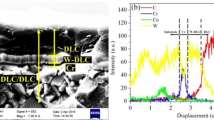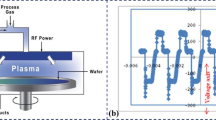Abstract
In an effort to prolong the tool life and improve the tooling performance in micro cutting, it is attractive and promising to apply diamond-like carbon (DLC) coatings on micro tools. Comprehensive understandings of micro cutting performance under various coating circumstances are essential for choosing optimum coating conditions so as for potentially improving cutting tool designs. In the study, the cutting characteristics of a DLC-coated tool has been extensively evaluated and compared with those of an uncoated tool under constant and various uncut chip thickness (UCT) using 2D plane-strain finite element method (FEM). The thermo-mechanical modelling approach has been validated at different UCT in micro milling. Besides, the influence of coating friction coefficient, coating thickness as well as UCT on the cutting forces and tool temperatures has been determined and analysed through design of experiment. It is found that appropriate UCT in micro cutting is of the greatest importance for achieving desirable coating performance of micro tools.
Similar content being viewed by others
References
Wu T, Cheng K (2012) An investigation on the cutting performance of nano-crystalline diamond coatings on a micro-end mill. Proc Inst Mech Eng B J Eng Manuf 226(8):1421–1424
Heaney PJ, Sumant AV, Torres CD, Carpick RW, Pfefferkorn FE (2008) Diamond coatings for micro end mills: enabling the dry machining of aluminium at the micro-scale. Diam Relat Mater 17:223–233
Childs THC, Maekawa K, Obikawa T, Yamane Y (2000) Metal machining: theory and applications. Arnold, London
Dai M, Zhou K, Yuan Z, Ding Q, Fu Z (2000) The cutting performance of diamond and DLC-coated cutting tools. Diam Relat Mater 9:1753–1757
Fukui H, Okida J, Omori N, Moriguchi H, Tsuda K (2004) Cutting performance of DLC coated tools in dry machining aluminium alloys. Surf Coat Technol 187:70–76
Hanyu H, Kamiya S, Murakami Y, Kondoh Y (2005) The improvement of cutting performance in semi-dry condition by the combination of DLC coating and CVD smooth surface diamond coating. Surf Coat Technol 200:1137–1141
Heinemann RK, Hinduja S (2009) Investigating the feasibility of DLC-coated twist drills in deep-hole drilling. Int J Adv Manuf Technol 44:862–869
Wu T, Cheng K (2013) Micro milling performance assessment of diamond-like carbon coatings on a micro end mill. Proc Inst Mech Eng Part J: J Eng Tribol 227(9):1038–1046
Sheikh MA, Mativenga PT, Iqbal SA (2007) Characterization of machining of AISI 1045 steel over a wide range of cutting speeds, part 2: evaluation of flow stress models and interface friction distribution schemes. Proc Inst Mech Eng B J Eng Manuf 221(5):917–926
Özel T (2006) The influence of friction models on finite element simulations of machining. Int J Mach Tools Manuf 46(5):518–530
Wu T, Cheng K, Rakowski R (2012) Investigation on tooling geometrical effects of micro tools and the associated micro milling performance. Proc Inst Mech Eng B J Eng Manuf 226(9):1442–1453
Wu T, Cheng K (2012) 3D FE-based modelling and simulation of the micro milling process. Proc Precis Eng Nanotechnol Key Eng Mater 516:634–639
Chen MJ, Ni HB, Wang ZJ, Jiang Y (2012) Research on the modeling of burr formation process in micro-ball end milling operation on Ti-6Al-4 V. Int J Adv Manuf Technol 62(9–12):901–912
Deng WJ, Xia W, Tang Y (2009) Finite element simulation for burr formation near the exit of orthogonal cutting. Int J Adv Manuf Technol 43(9–10):1035–1045
Wu HB, Zhang SJ (2014) 3D FEM simulation of milling process for titanium alloy Ti-6Al-4V. Int J Adv Manuf Technol 71(5–8):1319–1326
Wang JS, Gong YD, Abba G, Antoine JF, Shi JS (2009) Chip formation analysis in micromilling operation. Int J Adv Manuf Technol 45(5–6):430–447
Johnson GR, Stryk RA, Holmquist TJ and Beissel SR (1996) User instruction for the 1996 version of the EPIC code. Alliant Techsystems Inc
Medaska MK, Nowag L, Liang SY (1999) Simultaneous measurement of the thermal and mechanical effectiveness of cutting fluid. J Mach Sci Technol 3(2):221–237
Montgomery DC (2001) Design and Analysis of Experiments. Wiley
Author information
Authors and Affiliations
Corresponding author
Rights and permissions
About this article
Cite this article
Wu, T., Cheng, K. An investigation on the micro cutting performance of diamond-like carbon coatings using finite element method. Int J Adv Manuf Technol 73, 1321–1340 (2014). https://doi.org/10.1007/s00170-014-5904-6
Received:
Accepted:
Published:
Issue Date:
DOI: https://doi.org/10.1007/s00170-014-5904-6




